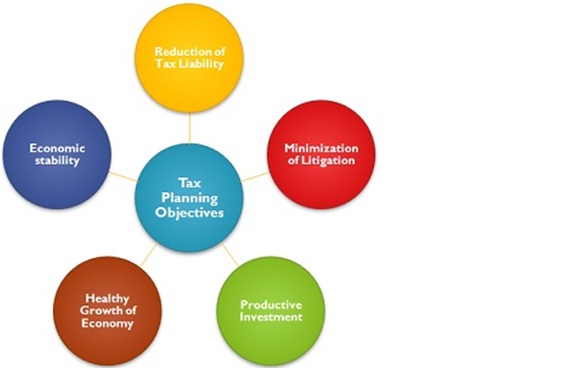- +91 7303202202
-


Tax planning is a process of analyzing one’s financial situation logically with an aim to reduce tax liability through the best use of all available allowances, exclusions, deductions and exemptions under the income tax act 1961.
The Income Tax Act contains a total of 23 chapters and 298 sections according to the official website of the Income Tax Department of India.These different sections deal with various aspects of taxation in India. The various heads for which you have to pay income tax include:

Short-range planning means planning made annually to fulfill the limited or specific objectives. It is executed at the end of the year to reduce taxable income legally. Also, in short-range tax planning there is no permanent commitment. An individual may invest in NSCs (National savings certificate) or PPF (Public Provident Fund) within the prescribed limit when income is increased. It is not advisable to take LIC/ULIP/Pension Plan etc
Long range tax planning means a definite plan chalked out at the beginning of the income year to be followed around the year. This type of planning does not help immediately as in the case of short range planning but is likely to help in the long run ; Long range tax planning refers to the practices undertaken by the assesse. Long term planning is done at the beginning or the income year to be followed around the year. Long term planning does not help immediately, For example transfer of assets without consideration to minor child. In this acase, the income will be combined to transferor up to the child in minor but once the child turns 18, this will be the child’s income.
Permissive tax planning refers to the plans which are permissible under various provisions of the law, for example planning of earning income covered by Section 10, Section 10(1), planning of taking advantage of various deductions, incentives for getting benefit of different tax concessions etc. In other words, it means planning made as per provision of the taxation laws.
Purposive tax planning means applying tax provisions in an intellectual manner so as to avail the tax benefits based on national priorities. It includes tax planning with a purpose of getting the maximum benefit by making suitable program for replacement of assets, correct selection of investment, varying the residential status and diversifying business activities and income. Also, Under Income Tax Act, Section 60 to Section 65 is related to the income of other persons included in the income of assesse. Here, assesse can plan in a way that the provisions do not get attracted so as to increase the disposable resources. This is known as purposive tax planning.
The primary objectives of your tax planning should be the following:

| Section | Permissible limit | Type of investment, expense or income | Eligible claimants |
|---|---|---|---|
| 80C | Maximum Rs. 1,50,000 (aggregate of 80C, 80CCC and 80CCD) | PPF, EPF, Bank FD's, NSC, LIC premium, tuition fees | Individuals, HUFs |
| 80CCC | Maximum Rs. 1,50,000 (aggregate of 80C, 80CCC and 80CCD) | Pension funds | Individuals |
| 80CCD | Maximum Rs. 1,50,000 (aggregate of 80C, 80CCC and 80CCD) | Pension fund initiated by central government | Individuals |
| 80TTA | Up to Rs. 10,000 per year | Interest on bank savings account | Individuals and HUFs |
| 80CCG | 50% of amount invested subject maximum of Rs. 25,000 | Equity saving schemes | Individuals |
| 80CCF | Up to Rs. 20, 000 | Long term infrastructure bonds | Individuals and HUFs |
| 80D | For individual taxpayers- Premium up to Rs. 25,000 in case of individuals and up to Rs. 30,000 for senior citizens | Medical insurance premium and Health check up | Individuals and HUFs |
| For HUFs- Premium up to Rs. 25,000 and up to Rs. 30,000 in case the member insured is a senior citizen or super senior citizen | |||
| 80E | No limit defined | Interest on repayment of Education loan | Individuals |
| 80EE | Maximum Rs. 50,000 | Interest on loan payable for acquiring a residential house property | Individuals |
| 80G | Differs with the amount of donation | General donations of any recognized society | Individuals, HUF's, Companies, Firms |
| 80GGA | Depends on quantum of donation | Donations to Scientific Research or Rural development | Those who do not have income from business or profession |
| 80GGB | Depends on quantum of donation | Donations to political parties | Indian companies |
| 80GG | Rs. 5000 per month or 25% of total income whichever is less | Rent paid if HRA is not received | Individuals not receiving HRA |
| INCOME TAX SLAB & RATES-FY 2019-20(AY 2020-21) | |||
| Income Slabs | Individuals Age less than 60 yrs | Sr.Citizens Age 60-80 yrs | Sr. Citizens Age 80 yrs & above |
| 0- Rs2.5 Lakhs | Nil | Nil | Nil |
| Rs2.5-Rs3.0 Lakhs | 5% | Nil | Nil |
| Rs3.0- Rs5.0 Lakhs | 5% | 5% | Nil |
| Rs5.0- Rs10.0 Lakhs | 20% | 20% | 20% |
| Rs10.0 and above | 30% | 30% | 30% |
| Surcharge:10% surcharge on income tax if the total income exceeds Rs.50 Lakhs but below Rs.1 Cr. 15% surcharge on income tax if the total income exceeds Rs.1 Cr. | Health and Education cess:4% Cess on income tax including surcharge. It is replaced with earlier 2% Education Cess and 1% Secondary and Higher Education Cess from Budget 2018. | ||


+91 7303202202
BaronRock Wealth
Grow More Tower,Office No-108,
Plot-05,Sec-02,Kharghar,
Navi Mumbai-410210
Copyright © BaronRock Wealth. All rights reserved.